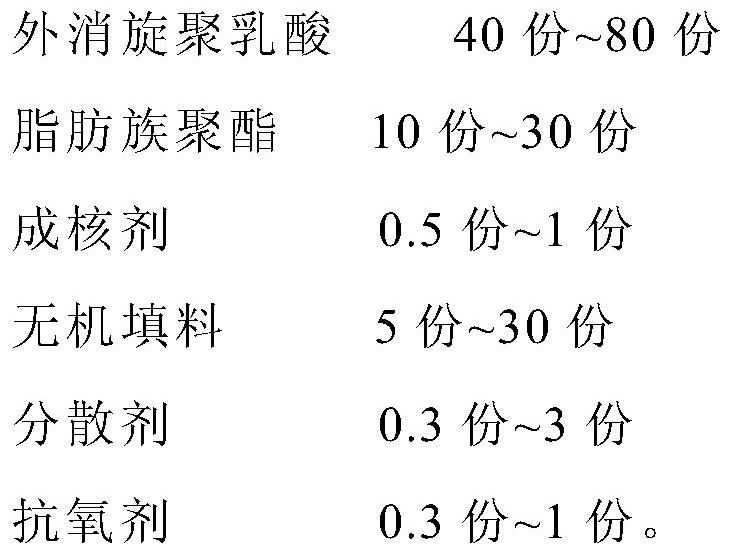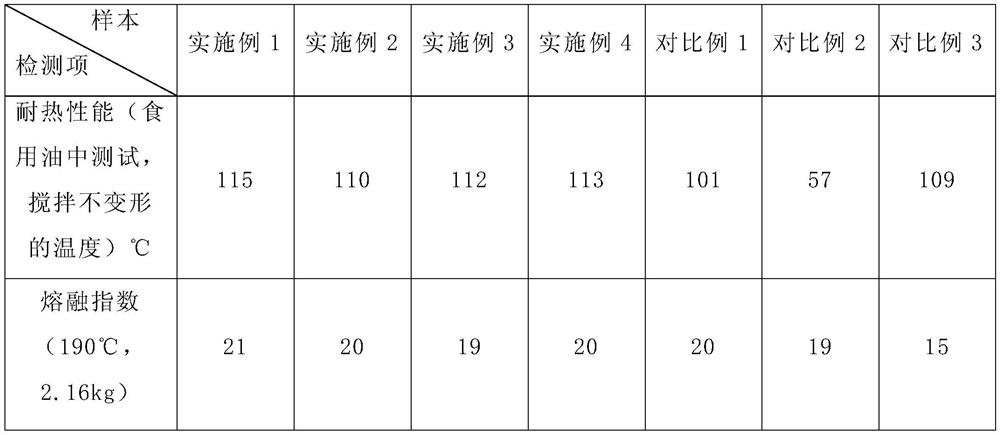PLA heat-resistant knife, fork and spoon and production method
A cutlery, heat-resistant technology, applied in the field of polymer materials, can solve the problems of easy softening, loss of basic functions of cutlery and spoons, and inability to meet the use function of tableware, so as to improve heat resistance, improve product application range, and facilitate high efficiency. The effect of processing
- Summary
- Abstract
- Description
- Claims
- Application Information
AI Technical Summary
Problems solved by technology
Method used
Image
Examples
Embodiment 1
[0023] Embodiment 1: PLA heat-resistant cutlery, its raw materials include: racemic polylactic acid 77.5kg, polybutylene succinate 10kg, talcum powder 10kg, EBS dispersant 1kg, TMC-306 polylactic acid nucleating agent 1kg, antioxidant 1010 0.5kg.
[0024] The preparation process is as follows:
[0025] S1: Preparation of polylactic acid from lactic acid by a two-step method, prepolymerization with a catalyst at 125°C and a vacuum of -80Kpa to prepare a polylactic acid prepolymer, and then high temperature cracking at 200°C to obtain crude lactide. Lactide is purified by recrystallization to obtain refined lactide;
[0026] S2: Add catalyst to purified lactide, polymerize polylactic acid at 120°C and vacuum degree of -90KPa, mix poly-L-lactic acid and poly-D-lactic acid to prepare racemic polylactic acid, and cut into pellets for later use;
[0027] S3: Add racemic polylactic acid, polybutylene succinate, TMC-306 polylactic acid nucleating agent, talcum powder, EBS dispersant...
Embodiment 2
[0031] Embodiment 2: PLA heat-resistant cutlery, its raw materials include: racemic polylactic acid 53kg, polybutylene succinate 14.5kg, talcum powder 30kg, EBS dispersant 1.5kg, TMC-300 polylactic acid nucleation Agent 0.5kg, antioxidant 1076 0.5kg.
[0032] S1: Preparation of polylactic acid from lactic acid by two-step method, prepolymerization with catalyst at 130°C and vacuum degree of -80Kpa to prepare polylactic acid prepolymer, and then high temperature cracking at 220°C to obtain crude lactide, and crude lactide Lactide is purified by recrystallization to obtain refined lactide;
[0033] S2: Add catalyst to purified lactide, polymerize polylactic acid at 140°C and vacuum degree of -99KPa, mix poly-L-lactic acid and poly-D-lactic acid to prepare racemic polylactic acid, and cut into pellets for later use;
[0034] S3: Add racemic polylactic acid, polybutylene succinate, TMC-300 polylactic acid nucleating agent, talcum powder, EBS dispersant and antioxidant 1076 to the...
Embodiment 3
[0038] Embodiment 3: PLA heat-resistant knife, fork and spoon, its raw materials include: racemic polylactic acid 65kg, polybutylene succinate 14kg, calcium carbonate 19.2kg, EBS dispersant 0.5kg, TMC-306 polylactic acid nucleation Agent 0.5kg, antioxidant 164 0.8kg.
[0039] The preparation process is as follows:
[0040] S1: Preparation of polylactic acid from lactic acid by two-step method. Under the condition of 140°C and vacuum degree of -80Kpa, catalyst prepolymerization was added to prepare polylactic acid prepolymer, and then high temperature cracking at 230°C to obtain crude lactide. Lactide is purified by recrystallization to obtain refined lactide;
[0041] S2: Add catalyst to purified lactide, polymerize polylactic acid at 140°C and vacuum degree of -89KPa, mix poly-L-lactic acid and poly-D-lactic acid to prepare racemic polylactic acid, and pelletize for later use;
[0042] S3: Add polylactic acid, polybutylene succinate, TMC-306 polylactic acid nucleating agent...
PUM
| Property | Measurement | Unit |
|---|---|---|
| optical purity | aaaaa | aaaaa |
Abstract
Description
Claims
Application Information
 Login to View More
Login to View More - R&D
- Intellectual Property
- Life Sciences
- Materials
- Tech Scout
- Unparalleled Data Quality
- Higher Quality Content
- 60% Fewer Hallucinations
Browse by: Latest US Patents, China's latest patents, Technical Efficacy Thesaurus, Application Domain, Technology Topic, Popular Technical Reports.
© 2025 PatSnap. All rights reserved.Legal|Privacy policy|Modern Slavery Act Transparency Statement|Sitemap|About US| Contact US: help@patsnap.com



